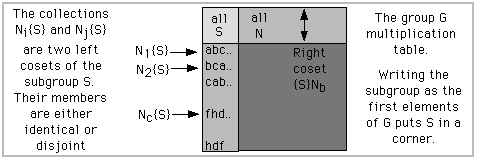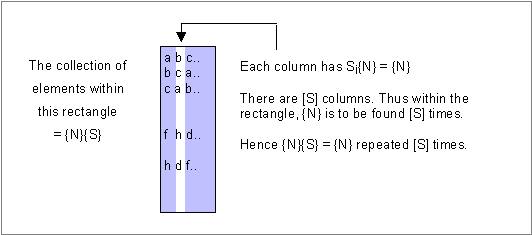
|
For a motion graphic tutorial on groups in the theory of symmetry see Physics As Symmetry. There group members are 'altered scrutinies' of inspection.
A 'group' is a collection of members which satisfy some prescribed elemental mathematical criteria. (See Exhibit 9 in Physics As Symmetry for a list of the five criteria.) The essential effect of these criteria is that a multiplication table (Exhibit 7, Physics As Symmetry) may always be constructed from the members of a group. A subgroup consists of a collection of members within the group that, themselves, make up a group. The members, Si, of the subgroup have a complete multiplication table of their own. That SiSj = Sk for any i,j is the key property that marks the collection {S} as a subgroup of {G}.
The brackets { } refer to a collection of items. Thus
The whole group, G, is parceled into subgroup members S, and non-subgroup ones N. The square brackets [ ] refer to the number of members in a collection. Thus the 'order' or size of {S} is [S]. The 'order' of {G} - the number of its members - is [G].
An important theorem due to Lagrange relates the size, [S], of the subgroup to the size, [G], of the group:
What follows is a proof of this theorem.
The ordering of G first by members of S followed by members of N exhibits the subgroup S in the Cayley Table (multiplication table, sequential action table) as a block within the whole table. One corner of the table contains elements belonging only to this subgroup as seen in the figure.

|
Such collections appear in the multiplication table as the rows in the rectangle array shown in the figure. The significant feature of these collections is this:
Any two of them have either all elements in common or none in common.
The statement that "two left cosets have all their members in common or none in common" means that "the collection Na{S} is either equal to the collection Nb{S} or disjoint from it".
In the figure N2{S} and Nc{S} are disjoint. They have no members in common. But N1{S} and N2{S} have all their members in common.
This all-or-none property follows from this simple finding: |
 |
August 1997
Marvin Chester
email: chester@physics.ucla.edu
© m chester 1997 Occidental CA